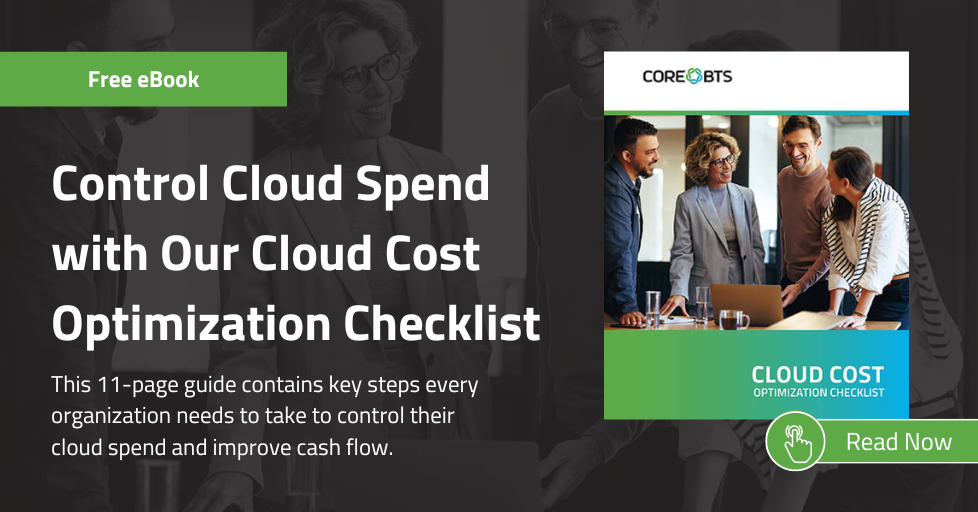The cloud made app development, data management, storage, and computing faster and easier – but now bills are coming due. And they’re not pretty. But we know it doesn’t have to be this way. Stop the money drain and take control of your cloud spend today with CoreStratus – an Azure Cloud Cost Optimization and Financial Governance Solution from Core BTS.
In our modern digital landscape, these words are not just a call to action – they represent a basic step needed for all businesses aiming to achieve maximum efficiency and cost-effectiveness with their cloud infrastructure.
Cloud cost management is not just about cutting costs – it’s about creating an automated, optimized environment that can adjust and scale according to your current workloads. It’s also about predicting and controlling your spending on cloud services, eliminating wasteful expenditures, avoiding overloaded systems, and making the most of your cloud investment.
Whether you’re currently grappling with managing your cloud expenditure or just starting to explore the potential of cloud computing, this article will be your roadmap to efficient cloud spend management. We will look at cloud cost management tools that can aid your cloud spend management workflows, as well as practical steps you can take to implement and optimize your cloud cost management initiatives.
The Need for Effective Cloud Spend Management
The increased demand for cloud services, like Amazon Web Services (AWS) and Microsoft Azure, has changed how businesses operate. And multi-cloud strategies have opened the doors to various cloud resources at your disposal.
The benefits of a multi-cloud environment come with the need to manage your cloud spend effectively. Without proper management, cloud costs can quickly spiral out of control, eating into your organization’s budget and compromising the overall value of your cloud investments.
Common Challenges with Cloud Cost Optimization
Businesses face numerous challenges in managing cloud costs, including a lack of visibility into resource usage patterns, intricate pricing models, and a lack of resources or skills to optimize spend. To add to the complexity, the multi-cloud approach, while advantageous, often results in disconnected cost management and oversight difficulties.
A comprehensive strategy for managing cloud spend is not just good practice – it’s essential for maintaining financial health and extracting maximum value from your cloud initiatives. Cloud migration and management innovations have made it easier for businesses to handle these challenges more effectively.
Understanding the Intricacies of Cloud Spend Management
Cloud spend management goes beyond tracking how much is spent on cloud resources. It’s an in-depth cost analysis focusing on cost visibility, allocation, and controlling and optimizing your cloud expenditures. (Get your free copy of our Cloud Cost Optimization Checklist.)
Resource management is a crucial aspect of this process. It involves tracking individual cloud resources, identifying underutilized or idle resources, and ensuring each resource is appropriately sized for its workload. This approach helps prevent overspending on resources that are larger or more powerful than necessary.
Budgeting is another vital component of financial management. It involves setting spending limits for specific projects, teams, or resources and tracking actual spending against these budgets.
Forecasting is also an integral part of cloud spend management. By analyzing historical usage data, you can anticipate changes in your cloud spending and better predict future trends. This approach can help you plan for spikes in demand or take advantage of discounts offered by cloud providers for predictable, consistent cloud usage.
All these elements work together to create a comprehensive and actionable cloud monitoring and management strategy. Understanding these intricacies in Azure or any other cloud environment is key to cost savings and efficient cloud spend management.
Cloud Cost Management Tools to Improve Your Workflow
Effective cloud spend management isn’t merely about understanding the complexities of cloud costs – it’s also about employing the right tools to manage these costs. Various specialized tools are available to optimize cloud costs, allowing for more refined control over your cloud infrastructure.
Dashboards are a cornerstone in this toolset. They visually represent your cloud spend, breaking down costs by service, department, project, or even individual resources. Dashboards offer a real-time view of your spending, allowing you to monitor costs as they occur and immediately address any anomalies.
Predictive analytics take cost management a step further. By leveraging machine learning algorithms, these tools can analyze past usage patterns and forecast future spending. They provide insights that help plan for future costs, identify potential overspend, and make informed decisions about cloud resource usage.
Real-time reporting complements these other tools by providing timely and detailed information about your cloud spend. Such reporting can alert you to unexpected spikes in usage, enabling you to respond swiftly to avoid unnecessary expenses.
Integrating these tools within your cloud environment can modernize your legacy systems, streamlining your cloud cost management efforts.
How to Implement Cloud Spend Management
With a solid understanding of the complexities of cloud spend management and the tools at your disposal, you’re now equipped to implement an effective cloud spend management strategy. The following points will give you a good start for creating a system that is tailored to your organization’s needs:
1. Rightsizing: Ensure your cloud services are correctly sized to match your workloads. Oversized resources are a common source of unnecessary costs. Tools can help identify underused or idle resources, offering recommendations for rightsizing.
2. Cost Allocation: Allocate costs to the proper departments, projects, or resources. Accurately attributing costs can create accountability and encourage cost-saving behaviors across your organization.
3. Load Balancing: Use load balancing to efficiently distribute workloads across your resources. This approach can optimize resource usage and prevent overpaying for unused capacity.
4. Pricing Models: Understand the pricing models of your cloud provider. For instance, many public cloud providers offer discounted rates for reserved instances or savings plans.
5. Real-Time Monitoring: Regularly monitor your cloud spend in real-time to identify unexpected costs. Immediate action can often mitigate these costs before they accumulate.
6. Spot Instances: Take advantage of spot instances if your cloud provider offers them. Spot instances are spare cloud computing capacity you can bid for at a fraction of the regular on-demand price. They are great for workloads that are not time-sensitive or can withstand interruptions.
Read more about the 8 key principles of cloud cost optimization.
Optimizing Your Cloud Costs
Implementation of an effective cloud spend management solution is merely the beginning. The real value unfolds as you optimize your cloud costs, fine-tuning your approach to extract the maximum benefit from your cloud investments. This continuous process involves harnessing technology, being versatile with your cloud environments, and implementing DevOps practices for optimal cloud cost management.
Machine Learning is at the forefront of cloud cost optimization. These technologies analyze vast amounts of data to identify patterns, predict trends, and provide actionable insights that inform your cost management strategies. For example, machine learning algorithms can forecast usage patterns, allowing you to optimize your reserved instances and realize significant cost savings.
Operating in a multi-cloud environment can also be a game-changer. You can optimize your cloud usage and reduce costs by leveraging the unique strengths and pricing models of different cloud providers. However, managing costs across multiple providers necessitates a comprehensive management solution that provides a unified view of your cloud spend.
Hybrid cloud environments offer another opportunity for optimization. You can balance cost efficiency with security and performance by combining public and private cloud resources. This approach allows you to allocate workloads based on their specific needs, further optimizing your cloud usage.
DevOps practices can also contribute to cloud cost optimization. By fostering collaboration between development and operations teams, these practices ensure that cloud resources are used efficiently throughout the development lifecycle. DevOps tools also enable the automation of resource provisioning and de-provisioning, preventing idle resources and wastage.
Optimizing cloud costs also includes implementing machine monitoring. It’s another area where technology is revolutionizing operations, enhancing the ability to track and manage performance.
Secure Your Financial Future with Effective Cloud Spend Management
While the flexibility and scalability of cloud services like AWS, Azure, and Google Cloud offer significant potential for growth and innovation, the complexity of cloud cost management can pose substantial challenges.
In the face of these challenges, a practical approach to cloud spend management is the key to unlocking the full value of the cloud.
Managing your cloud spend effectively is crucial in securing your financial future. It helps you control costs and empowers you to reinvest the savings into areas that drive business growth and innovation.
It’s no longer just about cutting costs; it’s about strategically managing your resources to fuel your organization’s success in the digital age.
Ready to Maximize Your Cloud Investments?
Core BTS is committed to helping you maximize your cloud investments. Our managed services offerings include tailored solutions designed to meet your unique business needs.
With our expertise in cloud cost management, our team will equip you with the tools and strategies to optimize your cloud spend, boost operational efficiency, and drive business value.
To learn more about how Core BTS can help maximize your technical investment with managed services, contact our team today. Together, we can transform the challenge of cloud cost management into a strategic advantage for your organization.





